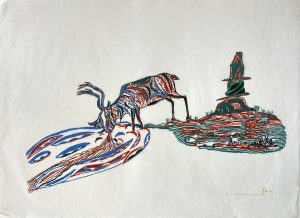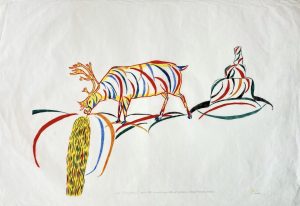- You cannot add "Dream Fish" to the cart because the product is out of stock.
William Noah
William Noah was a graphic artist based out of Qamani’tuaq (Baker Lake), NU, who also worked in politics and was a prominent community member [1]. He was a member of the Northwest Territories Legislature from 1979–1982 and was elected mayor of Qamani’tuaq twice. He is the son of renowned artist Jessie Oonark RC, OCA and brother to many accomplished artists including Nancy Pukingrnak, Victoria Mamnguqsualuk (1930–2016) and Janet Kigusiuq (1926–2005).
When he was young, Noah’s mother encouraged him to draw and he began making works more consistently in 1963 and became a printmaker in 1965 [2]. Noah utilized photographs to create paintings and colourful pencil drawings using canvas, paper and sometimes plywood and worked with coloured pencils, acrylics, oils and digital prints. Shamanic references are a notable theme in Noah’s early work. These bold graphic works often depict shamans who, as apprentices, learn to rid themselves of flesh so that all that remains is their bones and internal organs [3]. In an artist interview, Noah described how we was interested in showing how humans and animals might look from the outside in. However, his main interest is in the Arctic landscape and the animals that inhabit it. His art often presents his own perspective of living in a settlement and engages with the urbanization of Qamani’tuaq.
In addition to his art practice, Noah has worked in arts administration, serving as the president of the Canadian Arctic Producers from July 1978 to May 1979 and as a former president of the Sanavik Co-operative. Noah’s work has been showcased around the world in dozens of exhibitions. The artist was also part of the exhibition Art and Cold Cash, a collaboration with Sheila Butler, Ruby Arngna’naaq, Patrick Mahon and Jack Butler [4]. Together they held a number of group exhibitions. Noah has contributed writing and pieces to two exhibition catalogues: Qamanttiaq: Where the River Widens, Drawings by Baker Lake Artists (1995), and the Exquisite Corpse Water Drawing Project (2014). He has pieces in the permanent collections of the National Gallery in Ottawa, ON, and the Canadian Museum of History in Gatineau, QC, among others.
-Inuit Art Foundation
Showing all 2 results

